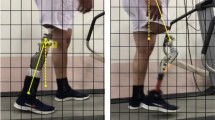Abstract
Due to recent heart attacks on humans, it is necessary to predict heart graphs of humans during running positions. On the other hand, hip and knee joints should be analyzed to predict walking and running conditions. Therefore, in this experimental works, hip, knee, and heart attacks are analyzed in experimentally. After experimental measurement, a proposed neural network is employed to predict hip, knee, and heart attack behavior of humans with walking and running stages.



















Similar content being viewed by others
Explore related subjects
Discover the latest articles, news and stories from top researchers in related subjects.Abbreviations
- b :
-
Recovery rate of chemical energy per unit mass
- b j :
-
Bias of the jth neuron in the hidden layer
- b k :
-
Bias of the kth neurons in the output layer
- c j :
-
Center of each hidden unit
- d :
-
Distal end of link
- e :
-
Actual reserves of chemical energy per unit mass
- F j :
-
Joint force
- f o :
-
Maximum propulsive per unit mass
- g :
-
Gravitational acceleration
- h :
-
Maximal vertical displacement
- I :
-
Moment of inertia
- m :
-
Mass of human body
- N :
-
Iteration number
- n I :
-
Number of neurons in the input layer
- n H :
-
Number of neurons in the hidden layer
- n O :
-
Number of neurons in the output layer
- P :
-
Electrical potential
- p :
-
Proximal end of link
- r j :
-
Radius vector of the jth hidden unit
- t :
-
Time
- T :
-
Joint torque
- v j :
-
Velocity of joint center
- \( \dot{\theta } \) :
-
Angular velocity
- α :
-
Momentum term
- μ :
-
Efficiency of transforming the chemical energy
- η :
-
Propulsive force setting parameter
- λ:
-
Learning rate
- τ :
-
Damping coefficient constant
- ϑ :
-
Speed of runner
- φ :
-
Monotonic function
References
Glaser D, Komistek RD, Cates HE, Mahfouz MR (2010) A non-invasive acoustic and vibration analysis technique for evaluation of hip joint conditions. J Biomech 43:426–432
Rakheja S, Dong RG, Patra S, Boileau PÉ, Marcotte P, Warren C (2010) Biodynamics of the human body under whole-body vibration: synthesis, of the reported data. Int J Ind Ergonomics 40:710–732
Sariali E, Stewart T, Jin Z, Fisher J (2008) Three-dimensional modeling of the hip kinematics under micro-separation regime. Noise analysis. J Biomech 41:S64
Yeow CH, Lee PVS, Goh JCH (2011) Non-linear flexion relationships of the knee with the hip and ankle, and their relative postures during landing. Knee 18:323–328
Modenese L, Phillips ATM (2011) Prediction of hip contact forces and muscle activations during walking at different speeds. Multibody Syst Dyn. doi:10.1007/s11044-011-9274-7
Freya M, Riener R, Michas C, Regenfelder F, Burgkart R (2006) Elastic properties of an intact and ACL-ruptured knee joint: measurement, mathematical modelling, and haptic rendering. J Biomech 39:1371–1382
Kitay GS, Koren MJ, Helfet DL, Parides MK, Markenson JA (2009) Efficacy of combined local mechanical vibrations, continuous passive motion and thermotherapy in the management of osteoarthritis of the knee. Osteoarthr Cartilage 17:1269–1274
Ribeiro A, Rasmussen J, Flores P, Silva LF (2011) Modeling of the condyle elements within a biomechanical knee model. Multibody Syst Dyn. doi:10.1007/s11044-011-9280-9
Henriksen M, Aaboe J, Simonsen EB, Alkjaer T, Bliddal H (2009) Experimentally reduced hip abductor function during walking: implications for knee joint loads. J Biomech 42:1236–1240
Heiden TL, Lloyd DG, Ackland TR (2009) Knee joint kinematics, kinetics and muscle co-contraction in knee osteoarthritis patient gait. Clin Biomech 24:833–841
Argatov I (2011) Development of an asymptotic modeling methodology for tibio-femoral contact in multibody dynamic simulations of the human knee joint. Multibody Syst Dyn. doi:10.1007/s11044-011-9275-6
Pena E, Calvo B, Martinez MA, Doblare M (2006) A three-dimensional finite element analysis of the combined behaviour of ligaments and menisci in the healthy human knee joint. J Biomech 39:1686–1701
Bogert AJVD, Reinschmidt C, Lundberg A (2008) Helical axes of skeletal knee joint motion during running. J Biomech 41:1632–1638
Rasool G, Mughal AM, Iqbal K (2010) Fuzzy biomechanical sit-to-stand movement with physiological feedback latencies, 2010 IEEE international conference on systems, man and cybern, pp 316–321
Walker R (2005) The human skeleton. Smart Apple Media, Franklin Watts
Chiras DD (2011) Human biology, Jones Bartlett Learning International, Canada
Zatsiorsky VM (2002) Kinetics of human motion. Human Kinetics, Champaign
Pridyy K, Keller PE (2005) Artificial neural networks: an introduction, the society of photo-optical instrumentation engineers
Yıldırım Ş, Eski İ (2010) Noise analysis of robot manipulator using neural networks. Robot Cim-Int Manuf 26:282–290
Acknowledgments
This research results consisted of a part of project FBA-10-2916. The authors wish to express their thanks to Erciyes University for supporting this project.
Author information
Authors and Affiliations
Corresponding author
Rights and permissions
About this article
Cite this article
Yildirim, Ş., Eski, İ. & Polat, Y. Design of adaptive neural predictor for failure analysis on hip and knee joints of humans. Neural Comput & Applic 23, 73–87 (2013). https://doi.org/10.1007/s00521-012-1211-z
Received:
Accepted:
Published:
Issue Date:
DOI: https://doi.org/10.1007/s00521-012-1211-z




